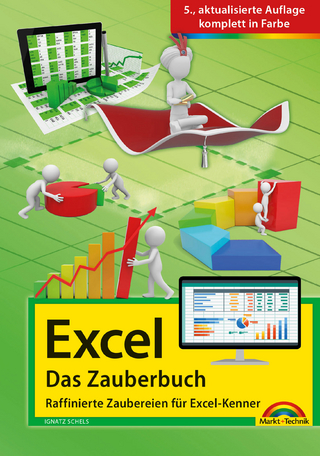
Decision Analytics
Que Corporation,U.S. (Verlag)
978-0-7897-5168-3 (ISBN)
- Titel ist leider vergriffen;
keine Neuauflage - Artikel merken
Overwhelmed by all the Big Data now available to you? Not sure what questions to ask or how to ask them? Using Microsoft Excel and proven decision analytics techniques, you can distill all that data into manageable sets—and use them to optimize a wide variety of business and investment decisions. In Decision Analytics: Microsoft Excel, best selling statistics expert and consultant Conrad Carlberg will show you how—hands-on and step-by-step.
Carlberg guides you through using decision analytics to segment customers (or anything else) into sensible and actionable groups and clusters. Next, you’ll learn practical ways to optimize a wide spectrum of decisions in business and beyond—from pricing to cross-selling, hiring to investments—even facial recognition software uses the techniques discussed in this book!
Through realistic examples, Carlberg helps you understand the techniques and assumptions that underlie decision analytics and use simple Excel charts to intuitively grasp the results. With this foundation in place, you can perform your own analyses in Excel and work with results produced by advanced stats packages such as SAS and SPSS.
This book comes with an extensive collection of downloadable Excel workbooks you can easily adapt to your own unique requirements, plus VBA code to streamline several of its most complex techniques.
Classify data according to existing categories or naturally occurring clusters of predictor variables
Cut massive numbers of variables and records down to size, so you can get the answers you really need
Utilize cluster analysis to find patterns of similarity for market research and many other applications
Learn how multiple discriminant analysis helps you classify cases
Use MANOVA to decide whether groups differ on multivariate centroids
Use principal components to explore data, find patterns, and identify latent factors
Register your book for access to all sample workbooks, updates, and corrections as they become available at quepublishing.com/title/9780789751683.
Conrad Carlberg has written eleven books about quantitative analysis with Excel, including Statistical Analysis: Microsoft® Excel 2010 and Predictive Analytics: Microsoft® Excel. His company, found at www.conradcarlberg.com, focuses on the quantitative analysis of data that companies routinely collect in their sales, employee, customer management and other operations database systems. Carlberg holds a Ph.D. in statistics from the University of Colorado and has 25 years’ experience applying advanced analytical techniques. Conrad Carlberg lives near San Diego with his wife, not too far from the beach, but high enough that the rise in the sea level is unlikely to convert their home to waterfront property. Two cats round out the indoor menagerie; the three rabbits are required to stay outside.
Introduction 1
What’s in the Book 1
Why Use Excel? 3
1 Components of Decision Analytics 5
Classifying According to Existing Categories 5
Using a Two-Step Approach 6
Multiple Regression and Decision Analytics 6
Access to a Reference Sample 8
Multivariate Analysis of Variance 9
Discriminant Function Analysis 10
Logistic Regression 12
Classifying According to Naturally Occurring Clusters 13
Principal Components Analysis 13
Cluster Analysis 14
Some Terminology Problems 16
The Design Sets the Terms 17
Causation Versus Prediction 18
Why the Terms Matter 18
2 Logistic Regression 21
The Rationale for Logistic Regression 22
The Scaling Problem 24
About Underlying Assumptions 25
Equal Spread 25
Equal Variances with Dichotomies 27
Equal Spread and the Range 28
The Distribution of the Residuals 29
Calculating the Residuals 30
The Residuals of a Dichotomy 30
Using Logistic Regression 31
Using Odds Rather Than Probabilities 32
Using Log Odds 33
Using Maximum Likelihood Instead of Least Squares 34
Maximizing the Log Likelihood 35
Setting Up the Data 35
Setting Up the Logistic Regression Equation 36
Getting the Odds 38
Getting the Probabilities 39
Calculating the Log Likelihood 40
Finding and Installing Solver 41
Running Solver 41
The Rationale for Log Likelihood 43
The Probability of a Correct Classification 44
Using the Log Likelihood 45
The Statistical Significance of the Log Likelihood 48
Setting Up the Reduced Model 50
Setting Up the Full Model 51
3 Univariate Analysis of Variance (ANOVA) 53
The Logic of ANOVA 54
Using Variance 54
Partitioning Variance 55
Expected Values of Variances (Within Groups) 56
Expected Values of Variances (Between Groups) 58
The F-Ratio 61
The Noncentral F Distribution 64
Single Factor ANOVA 66
Adopting an Error Rate 66
Computing the Statistics 67
Deriving the Standard Error of the Mean 70
Using the Data Analysis Add-In 72
Installing the Data Analysis Add-In 73
Using the ANOVA: Single Factor Tool 73
Understanding the ANOVA Output 75
Using the Descriptive Statistics 75
Using the Inferential Statistics 76
The Regression Approach 79
Using Effect Coding 80
The LINEST() Formula 82
The LINEST() Results 83
LINEST() Inferential Statistics 85
4 Multivariate Analysis of Variance (MANOVA) 89
The Rationale for MANOVA 89
Correlated Variables 90
Correlated Variables in ANOVA 91
Visualizing Multivariate ANOVA 92
Univariate ANOVA Results 93
Multivariate ANOVA Results 93
Means and Centroids 95
From ANOVA to MANOVA 96
Using SSCP Instead of SS 98
Getting the Among and the Within SSCP Matrices 102
Sums of Squares and SSCP Matrices 104
Getting to a Multivariate F-Ratio 105
Wilks’ Lambda and the F-Ratio 107
Converting Wilks’ Lambda to an F Value 108
Running a MANOVA in Excel 110
Laying Out the Data 110
Running the MANOVA Code 111
Descriptive Statistics 112
Equality of the Dispersion Matrices 113
The Univariate and Multivariate F-Tests 115
After the Multivariate Test 116
5 Discriminant Function Analysis: The Basics 119
Treating a Category as a Number 120
The Rationale for Discriminant Analysis 122
Multiple Regression and Discriminant Analysis 122
Adjusting Your Viewpoint 123
Discriminant Analysis and Multiple Regression 125
Regression, Discriminant Analysis, and Canonical Correlation 125
Coding and Multiple Regression 127
The Discriminant Function and the Regression Equation 129
From Discriminant Weights to Regression Coefficients 130
Eigenstructures from Regression and Discriminant Analysis 133
Structure Coefficients Can Mislead 136
Wrapping It Up 137
6 Discriminant Function Analysis: Further Issues 139
Using the Discriminant Workbook 139
Opening the Discriminant Workbook 140
Using the Discriminant Dialog Box 141
Why Run a Discriminant Analysis on Irises? 144
Evaluating the Original Measures 144
Discriminant Analysis and Investment 145
Benchmarking with R 147
Downloading R 147
Arranging the Data File 148
Running the Analysis 149
The Results of the Discrim Add-In 152
The Discriminant Results 153
Interpreting the Structure Coefficients 155
Eigenstructures and Coefficients 156
Other Uses for the Coefficients 159
Classifying the Cases 162
Distance from the Centroids 163
Correcting for the Means 164
Adjusting for the Variance-Covariance Matrix 167
Assigning a Classification 169
Creating the Classification Table 170
Training Samples: The Classification Is Known Beforehand 171
7 Principal Components Analysis 173
Establishing a Conceptual Framework for Principal Components Analysis 174
Principal Components and Tests 174
PCA’s Ground Rules 175
Correlation and Oblique Factor Rotation 176
Using the Principal Components Add-In 177
The Correlation Matrix 179
The Inverse of the R Matrix 179
The Sphericity Test 182
Counting Eigenvalues, Calculating Coefficients and Understanding Communalities 183
How Many Components? 184
Factor Score Coefficients 186
Communalities 186
Relationships Between the Individual Results 187
Using the Eigenvalues and Eigenvectors 187
Eigenvalues, Eigenvectors, and Loadings 188
Eigenvalues, Eigenvectors, and Factor Coefficients 190
Getting the Eigenvalues Directly from the Factor Scores 191
Getting the Eigenvalues and Eigenvectors 192
Iteration and Exhaustion 193
Rotating Factors to a Meaningful Solution 196
Identifying the Factors 197
The Varimax Rotation 200
Classification Examples 202
State Crime Rates 202
Physical Measurements of Aphids 206
8 Cluster Analysis: The Basics 209
Cluster Analysis, Discriminant Analysis, and Logistic Regression 209
Euclidean Distance 211
Mahalanobis’ D2 and Cluster Analysis 214
Finding Clusters: The Single Linkage Method 215
The Self-Selecting Nature of Cluster Analysis 220
Finding Clusters: The Complete Linkage Method 223
Complete Linkage: An Example 224
Other Linkage Methods 227
Finding Clusters: The K-means Method 228
Characteristics of K-means Analysis 228
A K-means Example 229
Benchmarking K-means with R 233
9 Cluster Analysis: Further Issues 235
Using the K-means Workbook 235
Deciding on the Number of Clusters 237
The Cluster Members Worksheet 239
The Cluster Centroids Worksheet 241
The Cluster Variances Worksheet 242
The F-Ratios Worksheet 244
Reporting Process Statistics 247
Cluster Analysis Using Principal Components 248
Principal Components Revisited 249
Clustering Wines 253
Cross-Validating the Results 256
Index 259
| Erscheint lt. Verlag | 21.11.2013 |
|---|---|
| Sprache | englisch |
| Maße | 180 x 231 mm |
| Gewicht | 444 g |
| Themenwelt | Informatik ► Office Programme ► Excel |
| Mathematik / Informatik ► Mathematik ► Finanz- / Wirtschaftsmathematik | |
| Wirtschaft ► Volkswirtschaftslehre ► Ökonometrie | |
| ISBN-10 | 0-7897-5168-2 / 0789751682 |
| ISBN-13 | 978-0-7897-5168-3 / 9780789751683 |
| Zustand | Neuware |
| Informationen gemäß Produktsicherheitsverordnung (GPSR) | |
| Haben Sie eine Frage zum Produkt? |
aus dem Bereich


